Wrapped inColor:Stranded Knitting in the 21st Century

Dedication
To Elizabeth Stockwell Dunkell Branham, a.k.a Gramma, who gave methat all-important unconditional parental love and approval. Grammanot only stirred my love for knitting, but also she made me believe all
those early, wonky, trapezoidal hole-filled scarves I knitted were perfect.I think about you every day, Gramma.
 Table of Contents
Table of ContentsAcknowledgmentsviiPrefaceix
Smoke and Mirrors Stranded Shawl Pattern26
The Hermitage: Keep on Textin Mitts Pattern31
Faux Doubleknit Wowl Cowl Pattern36Crazy Lazy Cables Hat Pattern40Ginko Textured Cowl Patetrn44
Saxony Pentagonal Shawl with Steek Pattern48
Snowflake Shawl Pattern53
Geometry Rules Lap Blanket Pattern57WendyP Parasol Pattern61Kaleidoscope of Color Shawl Pattern66Sweethearts Fleece-Lined Baby Wrap Pattern70Colorwork Combination Knitting73Blue Diamonds Color and Lace Pattern (cover)74About the Author and Contact Info78
AcknowledgmentsI am a technidiot, and I could not have completed this projectwithout the tireless help of so many of my knitting friends.Andrew, my husband, is not a knitter, but he has endured mywhining over my knitting and writing capabilitiesas well as thelonger list of my incapabilitiesfor long months. Hed rather bewatching TV. Thank you, Andrew. To the longsuffering members ofmy Ravelry group and to those I have burdened with endlessemail questions, I thank you for your patience and kind responses.To all the beautiful women who agreed to model my designs, Pia,Alicia, Stacey, Solange and the Cow Gals, at The Black Cow inCroton, thanks so much. To my wonderful knitting pals in my localknitting group, Croton on Hudson Gab and Knit, your support ispriceless. Id be lost without you. To Meaghan for coming up withthe title I loveits perfect. To Petra for taking great photos of thedesign pieces, you made Wrapped explode with color. Thank youWendy Preston for introducing me to the fantastic world ofcolorwork. It has changed my life. Who knew?To Wendy andJeanette Gingold please know how much I appreciate yoursupport, practical help, and your endless willingness to share yourvast publishing knowledge with me. A very special and heartfeltthank you to Marjorie Anderson, who undertook my every questionas a doctoral thesis, doing all kinds of research to answer meaccurately and thoroughly each and every time. I am so lucky to
viihave so many wise, talented and kind women as friends. In a veryreal way, you are my family.
viii
PrefaceSo many knitterseven seasoned onessee colorwork assomething complex and beyond their abilities. Not so ve ry longago, I was quite intimidated by the idea of stranding, and booksthat I looked at on the technique did not allay my fears. I want toshow all knitters that stranded knitting is far easier than theymight think, and that very complicated-looking designs are simpleto knit. My illustrations and easy-to-follow explanations will giveeven the most hesitant knitters the confidence to create beautifulgarments and accessories. By using the knit stitch alonebecauseI design in the round, my patterns for the most part do notrequire purlingeven the most inexperienced knitters can createpieces that comprise intricate colowork ideas. Stranded knitting isdeceptively easy.
Wrapped in Color offers a fresh and welcome approach to strandedknitting. It is a total departure from traditional stranding style.With a choice collection of my new-fashioned colorwork-in-theround patterns, accompanied by many attractive photos, there issomething in this book that will appeal to young knitters, as wellas those who are young at heart.I have replaced the traditionalideas of what colorwork is with new designs that have never beendone before. While any text included will be informative, it will belight, interesting, casual and entertaining.
ixThe book is long on visuals, tutorials and charts and short onwritten text. It covers all that color can accomplish in a knittedpiece. Color can convey mood. Color can be lace. Color can becables. Color can be texture. In short, color can be anything,and anyone can knit it.
x
IntroductionMany Fair Isle books open with the history of Fair Isle and otherstranded knitting techniques. Too many books do that. If you arelike me, you skip over those pages to get to the good stuff. I willspare you that history lesson but, because books need some text, Iwill supply a more personal history for those who dont want tojump right to the yummy patterns.
When I was growing up, I liked nothing better than to curl up andlose myself in a good Nancy Drew mystery. Well, maybe I likedchocolate cake better, but that doesnt work in this part of thestory. For all of my reading life, I have been able to completelylose my sense of time and work-a-day reality when immersed in agreat read. I couldnt imagine anything better. Until I learnedstranded knitting. I have been knitting since I was five years old,but my foray into the world of colorwork is relatively recent. Likeso many seasoned knitters, colorwork seemed daunting and farbeyond my abilities.
When Wendy Preston first joined our local knitting group, shebrought in some of her lovely projects to show us. One of them washer Mardi Gras sweater (by Alice Starmore), and I was slack-jawedblown-away. You knit that? How did you do that?! She told me itwas Fair Isle and, honestly, I had never heard of the technique. Ihad seen sweaters worked in it, but I assumed they were knitted onmachines. I had been knitting for 45 years, and I had never comeacross Fair Isle, or my memory failed me on that one. Nevertheless,I was blown away, and I knew I had to learn this technique. So, Ibought two balls of contrasting wool, a couple of how-to books, and Ipracticed. Ever compliant, I did just as the instructions demanded. Iheld one yarn in my right hand and one in my left. But try as Imight, I could not achieve even tensions between the two. I am athrower. My left hand is useless except for holding a needle orgetting coffee and the afore-mentioned chocolate cake to my mouth(and, make no mistake, coffee and chocolate are as important toknitting as wool). So, I kept practicing, but now, I simply knittedwith one yarn in my right hand, dropped it and picked up the otherstrand as I needed it. This worked, but it was clumsy and slowgoing. I needed something more convenient. Enter: toes. I put thesecond (sometimes called background) yarn between my toes and satback. It worked like a charm. I threw the first (foreground strand)yarn with my right hand as usual and then, when I needed to knita stitch with the other strand, I just hooked it with my pinky, orany other convenient digit, and kept going. A revised version of thisbizarre method still works for me today. Now, I thread both yarns inmy toes, much as I thread my sewing machine, and zip right alongchanging colors as my chart dictates. When knitting colorworkpatterns, I lose all sense of reality as we usually know it in ourwaking hours. It is pure zen for methe pure, in-the-moment,meditative existence that is bliss. Honestly, I am so very lucky to beable to spend my days doing what I love to do. And the only way Ican increase my joy is to show others how to achieve knittingnirvana, too.
What is Colorwork?Colorwork is a generic term applied to knitting that employs morethan one color yarn. Even simply striped pieces can be calledcolorwork, for example. Several techniques can be worked toachieve colorwork. Well discuss three of the more commonly usedmethods here:


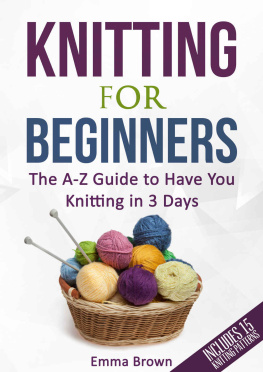
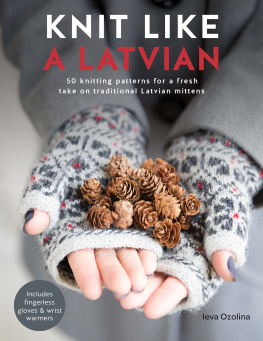
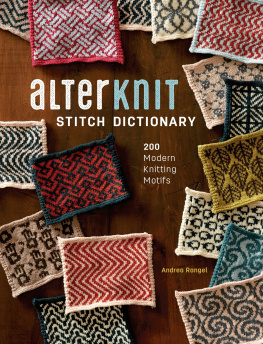
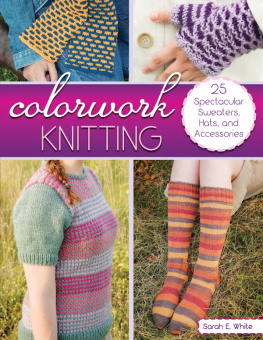
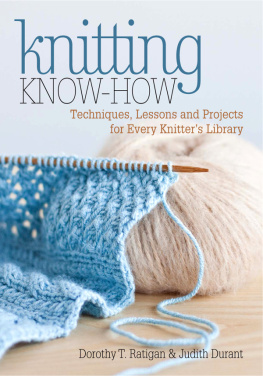

 Table of ContentsAcknowledgmentsviiPrefaceix
Table of ContentsAcknowledgmentsviiPrefaceix